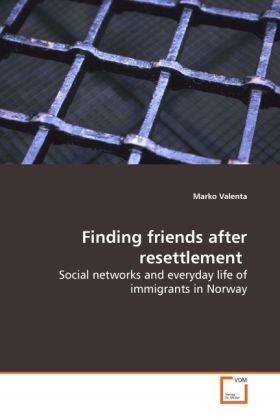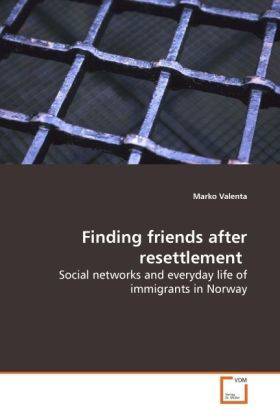
Je cadeautjes zeker op tijd in huis hebben voor de feestdagen? Kom langs in onze winkels en vind het perfecte geschenk!
- Afhalen na 1 uur in een winkel met voorraad
- Gratis thuislevering in België vanaf € 30
- Ruim aanbod met 7 miljoen producten
Je cadeautjes zeker op tijd in huis hebben voor de feestdagen? Kom langs in onze winkels en vind het perfecte geschenk!
- Afhalen na 1 uur in een winkel met voorraad
- Gratis thuislevering in België vanaf € 30
- Ruim aanbod met 7 miljoen producten
Zoeken
Finding friends after resettlement
Social networks and everyday life of immigrants in Norway
Marko Valenta
Paperback | Engels
€ 104,45
+ 208 punten
Omschrijving
Finding friends after resettlement attempts to
see beyond the debate that divides immigrant social
trajectories into simple processes of gradual
segregation and integration. The author maintains
that this dichotomy hides a wide latitude of social
trajectories and identity negotiations. Patterns of
social integration can be traced in the intersection
between face-to-face interactions that immigrants
have with others, features of their personal
network, and immigrant attempts to deal with these
dimensions. It is argued in this book that the most
realistic adaptation line for first generation non-
western immigrants in Norway would appear to be
different kinds of selective bridging to the
mainstream, based on weak ties with indigenous
locals. Nevertheless, this kind of bridging to the
mainstream should not be neglected and
underestimated. These friends and acquaintances
become symbols of acceptance that help newcomers
construct identities of themselves as people who are
included and respected in their new social
environment.
see beyond the debate that divides immigrant social
trajectories into simple processes of gradual
segregation and integration. The author maintains
that this dichotomy hides a wide latitude of social
trajectories and identity negotiations. Patterns of
social integration can be traced in the intersection
between face-to-face interactions that immigrants
have with others, features of their personal
network, and immigrant attempts to deal with these
dimensions. It is argued in this book that the most
realistic adaptation line for first generation non-
western immigrants in Norway would appear to be
different kinds of selective bridging to the
mainstream, based on weak ties with indigenous
locals. Nevertheless, this kind of bridging to the
mainstream should not be neglected and
underestimated. These friends and acquaintances
become symbols of acceptance that help newcomers
construct identities of themselves as people who are
included and respected in their new social
environment.
Specificaties
Betrokkenen
- Auteur(s):
- Uitgeverij:
Inhoud
- Aantal bladzijden:
- 356
- Taal:
- Engels
Eigenschappen
- Productcode (EAN):
- 9783639144642
- Verschijningsdatum:
- 10/04/2009
- Uitvoering:
- Paperback
- Afmetingen:
- 152 mm x 229 mm
- Gewicht:
- 522 g

Alleen bij Standaard Boekhandel
+ 208 punten op je klantenkaart van Standaard Boekhandel
Beoordelingen
We publiceren alleen reviews die voldoen aan de voorwaarden voor reviews. Bekijk onze voorwaarden voor reviews.









